 |
|
Close Call at Cape St. Elias |
||
This incident happened on a trip up from Seattle to Dutch Harbor, in the Aleutian Islands on our 104' steel king crabber, Flood Tide, in March of 1971.We have just left the sheltered waters of the Inside Passage. The mood in the pilothouse after supper was subdued. Astern was the sweeping beam of the light at Cape Spencer, the entrance to the sheltered waters of the Inside Passage. Ahead lay the immense Gulf of Alaska. The night was hazy, dark, and cloudless. The bow rose and fell with the long Pacific swells, and there was neither star nor horizon to guide us. Just before midnight, I rose, made coffee, and went up into the pilothouse to relieve Russell and take my midnight to 4 a.m. “graveyard watch.” The pilothouse was illuminated only by the dim numbers from the loran, radar, and instrument displays. A half moon had come up, shining starkly on the wall of ice and snow that rose from the shore ten miles east of us. |
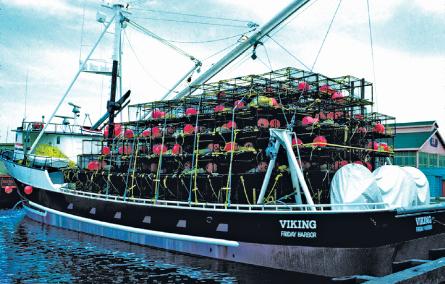 |
|||||
Crabber with pots stacked six layers high - if a vessel with this kind of a load got into heavy icing like we experienced off Cape St. Elias, it would probably capsize before the crew could either beat enough ice off or dump enough pots over the side to lower the center of gravity. |
||||||
Russell’s stubby forefinger punched down on the chart and he said: “Lituya Bay. You don’t want to go in there unless you really have to. All that water in them fjords and this bay have to pour in and out through that narrow entrance. You can go in if the tide’s flooding or slack if it’s not blowing heavy, but on the ebb that current stacks up the seas and it’s a boat-killer. That’s the hell about this part of the coast.” His finger traced the entrances to some other bays: Dry Bay and Dangerous River. “You get in a jam with some engine problem or bad weather and you need a harbor, and there’s no place to go. I’ve seen breakers out here, two full miles from shore. You want to give this coast a good berth.” Twenty miles north of Yakutat, one of the few good harbors along that coast, a wind came up. After five minutes it was blowing seventy. The temperature was fifteen degrees. The first spray over the bow froze instantly on the wheelhouse windows. Our skipper, George Fulton, turned the Flood Tide around with hardly a discussion. As we entered Yakutat Bay, all of us in the wheelhouse witnessed a sobering sight. The 140-foot trawler Deep Sea, pioneer of the king crab fishery, lay at anchor with a big covered barge in tow. She had iced up bad, as had her barge, all the corners and sharp angles softened by the smooth and sinister contours of thick ice. But the sobering part was the barge. The whole front of the structure built on it, a long metal warehouse of a building, was crumpled in, the top and sides mangled for a third of the way back and in places the aluminum sheeting had been ripped off like paper. George got the story over the radio: The barge was a floating shrimp cannery, headed for Kodiak, 400 miles to the west. They had gotten within 10 miles of the shelter of Cape St. Elias, 130 miles north of Yakutat, when the wind came up. Two hours later, the seas had punched in the front of the barge, forcing the Deep Sea skipper to turn around and run before the storm, icing as they went, all the way back to Yakutat. We tied our frozen lines to a silent cannery wharf, and I walked up to the village with Johnny and Missouri Bob in the blowing, drifting snow that was knee-deep. In all of Yakutat, we saw only two lighted windows, and nowhere a footprint or car track. We trudged back to the boat. With the bark of her diesel generator filling the night, our boat seemed like a visitor from another planet. A blizzard swept in from the Canadian Yukon after midnight. At the head of the harbor, in the lee of the great mountains, we lay sheltered from its force, but morning showed a gray and chilling world. Outside the windows of the pilothouse, a steady plume of snow settled on us, drifting down from the wharf above. By noon, the deck was almost waist deep with snow. It was as if we’d come to the edge of the world as we knew it. And we still had some 1,000 miles more to go. |
||
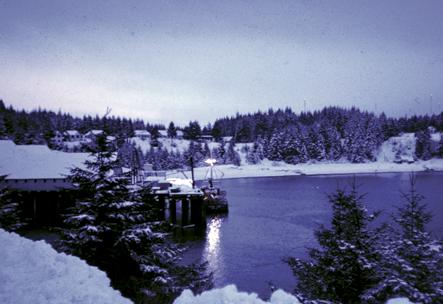 |
||||
Waiting out a blow at the Yakutat cannery dock. After dusk fell, the snow came on thick, swirling down from the empty cannery and we truly felt as if we had come to the edge of the known world. |
||||
That night, sometimes even over the reassuring hum of our diesel generator, we could hear the wind, screeching through the trees and cannery buildings above us. At 4 a.m., when we got up to sniff the air, to see if it was a chance, as mariners sometimes call a window of good weather, the storm had blown off into the wild desolate country to our the east. So we drew in our stiff lines and headed out of the still bay and into the Gulf of Alaska. The dawn, when it came, was truly awesome—first a faint yellow line, then a dozen peaks tinged with pink. The sun when it rose, was red and angry, lighting up thousands of square miles of bleak ice and rock with its strange long-shadowed light before it disappeared into thin, hazy, cloud cover. All day we steamed northwest, a few miles off the beach. The wind was offshore and light, our ride easy, but there was something about the day and place that made us all somber. The land to the north and east was a strip of beach, rising to ice fields and mountains as far as the eye could see, range after range of cold, white peaks. The coast was broken here and there by little bays, ice-choked and shallow, offering no shelter. The night came early and inky black and without a breath of wind. It seemed as if we were traveling through a featureless void. We ate early, then gathered in the darkened pilothouse, anxious to make Cape Hinchinbrook, the end of the most exposed passage. The tension in the air was thick, and finally I went below to an uneasy sleep. |
||
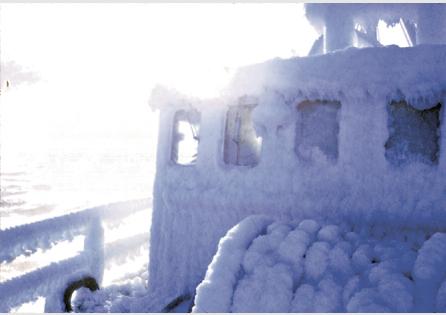 |
||||
Our 104' Marco crabber Flood Tide, with thick ice accumulated from freezing sea spray, Katalla, AK, 1971. In such conditions the pipe rails around the bow grow together, trapping water which quickly freezes, making the bow heavier and heavier. We iced up so badly on this particular night that we knew that if the wind was blowing just a little harder, we would be making ice faster than we could beat it off and would eventually capsize. |
||||
Sometime after midnight I woke up suddenly. The engine was only rumbling at an idle, but it was something else that had awakened me—the boat’s motion. She took a roll, slow and loggy, seeming to hesitate at the end. I stumbled up into the pilothouse. Outside the window was a terrible sight—the two-inch-thick pipe rails around the foredeck were swollen into foot-thick bloated ice sausages, and in a few places they already had grown together into a solid ice wall. The anchor winch was an unrecognizable white mound. I took a quick look out the back windows, and just as quickly looked away. What had been a neat stack of big crab pots was now a lumpy hill of white ice, broken here and there by the black steel edges of the pots. It was easy to see how vessels went down. In just a couple of hours, we’d accumulated enough ice to make the boat dangerously top-heavy, and we were only carrying fifty pots in a single layer on deck. Some larger vessels traveled north with their pots stacked three or four layers high. Within moments, the others had joined us. Without a word, Russell and I suited up with raingear over insulated coveralls. We grabbed a baseball bat and a hammer and edged cautiously out onto the foredeck, while Johnny and Bob did the same on the back deck. Clipping short safety lines from our waists to the rails, we knocked off the ice as we went. The ice popped off easily, but it was awkward work—the boat was rolling and pitching with that ominous slow motion, the footing was treacherous, and the bitter wind turned the spray to slush on our oilskins. Once a “queer one,” a wave larger than the others, loomed suddenly out of the night and solid, black water rose right up over the bow. It tugged at our knees and then was gone. But it was an ominous feeling—the bow sinking, the water swirling around us, clutching at our legs, our hands grabbing the icy rail. We could see George’s white, strained face in the window, but then the bow rose sluggishly and the water cleared from the deck. When we’d knocked off the tons of ice from the bow and shoveled it overboard, we worked aft, knocking the ice off the rails as we went. After an hour’s work, clearing the bow and boat deck area, our little ship seemed to ride a little higher, roll a little quicker, feel a little safer. The back deck was another story. Even the nylon mesh of the pots had swollen with the ice, having grown into a seamless white frozen mound. Much of what we chipped fell on deck and had to be shoveled over. And all the while the wind picked the water off the sea and froze it to every surface we had just uncovered. It was blowing perhaps twenty-five knots. We all knew that it would only take another twenty knots of wind to make ice faster than we could chip it off, and then it would only be a matter of time before we’d have to turn around and try to run out to sea with the wind behind us before we became too top heavy and simply rolled over. We had to find shelter and soon, and get as many pots below deck, into our holds, to reduce the area where ice could accumulate. At least here, I thought, we were near the land. If worst came to worst, I supposed, we could run the Flood Tide in towards the land and and try and find a sandy spot to beach her. Even that lonely shore would be a better place to walk home from than the Gulf of Alaska. |
||
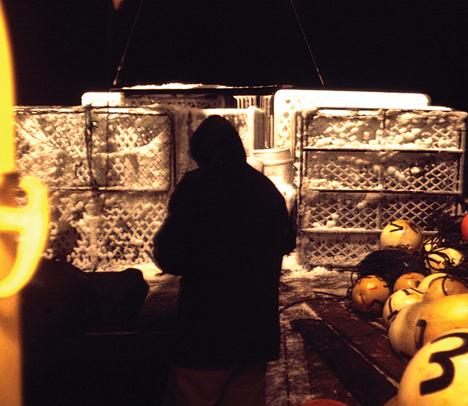 |
||||
Very fortunately we found a few acres of shelter behind an island near the abandoned town of Katalla. We opened our big hatches, broke the pots on deck free of the ice and winched as many as we could into the holds to lower our center of gravity. |
||||
It’s the Copper River wind, boy,” Russell told me in the galley when we had finished and were warming up. “All that ocean air just gets frozen up there, and suddenly decides to roll back to the sea, down the river valley. I told that guy down in Seattle to put the pots into the hold when we loaded them. ‘Oh, no,’ he said. ‘We won’t have to do that.’ Those guys don’t even know what ice is except when they see it in their drinks. They think these new super boats can take anything.” Even at less than a quarter throttle, we iced up again badly before we found a few acres of sheltered water behind a tiny dot of an island off the abandoned town of Katalla. We hoisted up the boom, lifted and set aside the heavy hatch covers, and loaded as many of the heavily iced pots into the hold as would fit. We laid the remaining dozen flat on the deck, then lowered the boom, and chained it to the stern rail. The icy wind still clawed at us, but there was no sea. When we were finally done I looked around. Except perhaps for the Coast Guard lighthouse keepers at Cape St. Elias, we were probably the only humans within fifty miles. The vista was unspeakably bleak: frozen islands, frozen shore, and frozen mountains, now hidden, now revealed by clouds racing past the moon. |
||
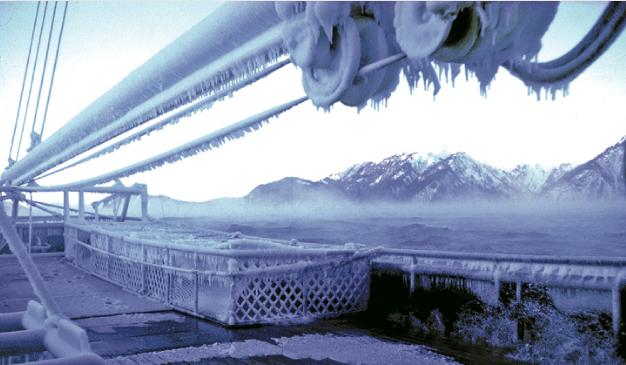 |
||||
Boom lowered and lashed, pots flat on the deck, we'd done all we could to lower our center of gravity. And still we iced dangerously... |
||||
This is an excerpt from my book, Bering Sea Blues, about the dramatic 1971 King Crab season in the Bering Sea.
|
||